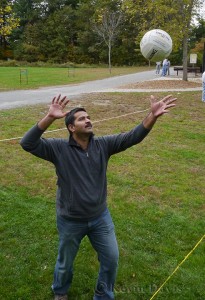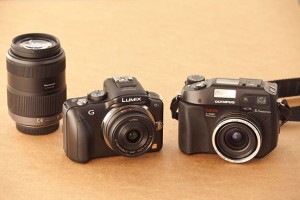In 2008, Vince Laforet shocked the film-making world with a short film called “Reverie” (http://vimeo.com/7151244). He shot this in just two days using a borrowed Canon EOS 5D mk II (borrowed from Canon) before the camera was released.
Since then, the 5D mk II has become a serious tool for film-makers, particularly because it is much smaller than existing cameras (those specifically designed for cinematography) … and also because the cost is a small fraction of those cinematography cameras.
Recently, Canon announced a successor for 2012, the EOS 5D mk III.
The overwhelming success of the 5D mk II for video purposes was somewhat surprising to everyone, including Canon and Nikon. Just a couple months prior to introduction of the 5Dm2, Nikon had introduced the first DSLR that supported 720 HD (not 1080). By most accounts, Nikon trailed behind the success of the 5D2, but successfully “caught up” with cameras such as the D7000, D4, and D800, all of which offer excellent 1080 HD video capture. By some measures, the D800 trumps the Canon 5D mk III.
All these cameras are built around CMOS image sensors that are far larger than what you find inside video camcorders. When combined with a system of interchangable lenses, film-makers can create effects and quality not possible with consumer or prosumer video camcorders.
Since the success of the 5D mk II, Canon has been on a mission to create new cameras specifically for cinematography (movies & television). Enter … the new EOS C300, EOS C500, and EOS 1D C (“c” is for cinema). Both the C500 and EOS 1D C can capture at digital resolutions higher than 1080 HD. While the EOS 1D C is an SLR that can shoot still images and video, the C300 and C500 are pure video machines that will capture 12-bit 4:4:4 color, compared to 8-bit 4:2.2 color in any DSLR.
While the EOS 1D C is the same size as the EOS 1D and 1Dx, it can capture 4K video at 24 fps or 1080 video at 60 fps. That’s a data output somewhere around 500 Megabytes/sec.
Canon recruited film-maker Shane Hurlbut to test out the new camera. He created a short film, entitled “The Ticket“.
http://www.hurlbutvisuals.com/blog/2012/04/looking-inside-the-canon1dc-dslr-4k-capture-project-the-ticket/
Canon’s new cinematography play is priced well for serious indie film-makers, but not for consumers. So, another interesting camera for 2012, is the new Blackmagic Cinema Camera, which shoots 2.5K video and costs less than $3K.
720 HD = 1280 x 720 (16:9)
1080 HD = 1920 x 1080 (16:9) Panavision Genesis, Sony CineAlta, Canon C300
and DSLRs: Canon 5D mk II, Canon 5D mk III, Canon 1Dx,
Nikon D7000, Nikon D800, Nikon D4
2K = 2048 x 1080 (17:9) Ari Alexa, Silicon Imaging SI-2K, Canon C500
2.5K = 2432 x 1366 (16:9) Blackmagic Cinema camera
4K = 4096 × 2160 (17:9) RED One, Red Scarlet, Canon C500, Canon 1D C



